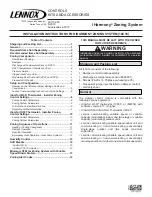
5. Set the refrigerant cylinder onto the electronic scale, then correct the hose the cylinder and to the connection port for the
electronic scale. (1)(2)
Precaution:
Be sure to set up the cylinder for liquid charging. If you use a cylinder equipped with a siphon tube, you can charge the liquid
without having to turn the cylinder around
6. Remove the charging hose of the manifold gauge from the vacuum pump adaptor, and connect it to the connection port of the
electronic scale. (2)(3)
7. Open the valve of the refrigerant cylinder, then open the charging valve slightly and close it. Next, press the check valve of the
manifold gauge and purge the air. (2)(4) (Watch the liquid refrigerant closely at this point.)
8. After adjusting the electronic scale to zero, open the charging valve, then open the valve Lo of the manifold gauge and charge
with the liquid refrigerant. (2)(5) (Be sure to read the operating instructions for the electronic scale.)
9. If you cannot charge the stipulated amount, operate the unit in the cooling mode while charging a little of the liquid at a time
(about 150 g/time as a guideline). If the charging amount is insufficient from one operation, wait about one minute, then use the
same procedure to do the liquid charging again.
Precaution:
Never use the gas side to allow a larger amount of liquid refrigerant to be charged while operating the unit.
10. Close the charging valve, and after charging the liquid refrigerant inside the charging hose, fully close the valve Lo of the
manifold gauge, and stop the operation of the unit. (2)(5)
11. Quickly remove the charging hose from the service port. (6) If you stop midway through, the refrigerant that is in the cycle will
be discharged.
12. After putting on the caps for the service port and operating valve, inspect around the caps for a gas leak. (6)(7)
Fig. 13 Re-charging refrigerant
10.4.6. Brazing
As brazing requires sophisticated techniques and experiences, it must be performed by a qualified person.
In order to prevent the oxide film from occurring in the pipe interior during brazing, it is effective to proceed with brazing while letting
dry nitrogen gas (N2) flow.
69
CS-VA75KE CU-VA75KE / CS-VA95KE CU-VA95KE / CS-VA125KE CU-VA125KE
Summary of Contents for CS-VA75KE
Page 12: ...4 Dimensions 12 CS VA75KE CU VA75KE CS VA95KE CU VA95KE CS VA125KE CU VA125KE...
Page 13: ...13 CS VA75KE CU VA75KE CS VA95KE CU VA95KE CS VA125KE CU VA125KE...
Page 14: ...5 Refrigeration Cycle Diagram 14 CS VA75KE CU VA75KE CS VA95KE CU VA95KE CS VA125KE CU VA125KE...
Page 15: ...15 CS VA75KE CU VA75KE CS VA95KE CU VA95KE CS VA125KE CU VA125KE...
Page 16: ...6 Block Diagram 16 CS VA75KE CU VA75KE CS VA95KE CU VA95KE CS VA125KE CU VA125KE...
Page 92: ...15 Technical Data 92 CS VA75KE CU VA75KE CS VA95KE CU VA95KE CS VA125KE CU VA125KE...
Page 94: ...94 CS VA75KE CU VA75KE CS VA95KE CU VA95KE CS VA125KE CU VA125KE...
Page 95: ...95 CS VA75KE CU VA75KE CS VA95KE CU VA95KE CS VA125KE CU VA125KE...
Page 96: ...96 CS VA75KE CU VA75KE CS VA95KE CU VA95KE CS VA125KE CU VA125KE...
Page 107: ...107 CS VA75KE CU VA75KE CS VA95KE CU VA95KE CS VA125KE CU VA125KE...
Page 109: ...23 1 REMOTE CONTROL 109 CS VA75KE CU VA75KE CS VA95KE CU VA95KE CS VA125KE CU VA125KE...
Page 112: ...112 CS VA75KE CU VA75KE CS VA95KE CU VA95KE CS VA125KE CU VA125KE MACC Printed in Malaysia...
















































